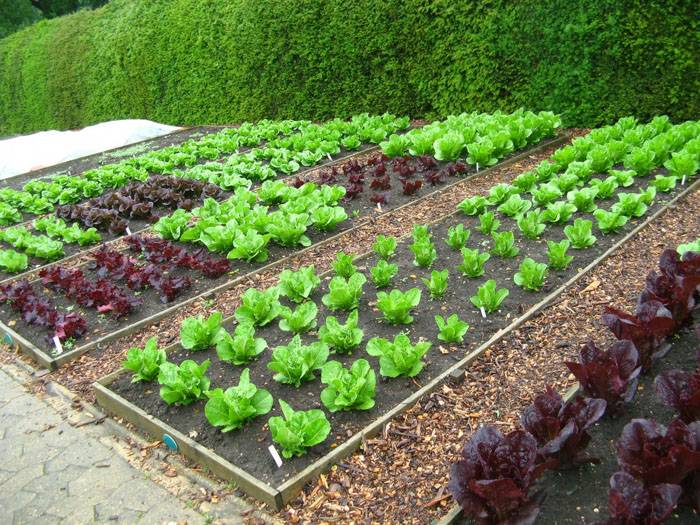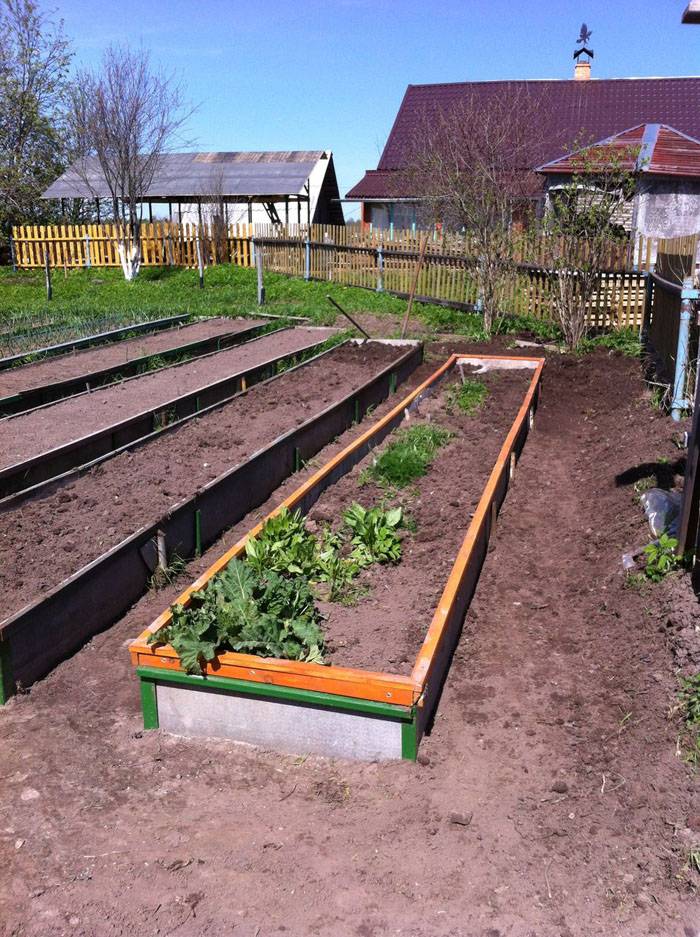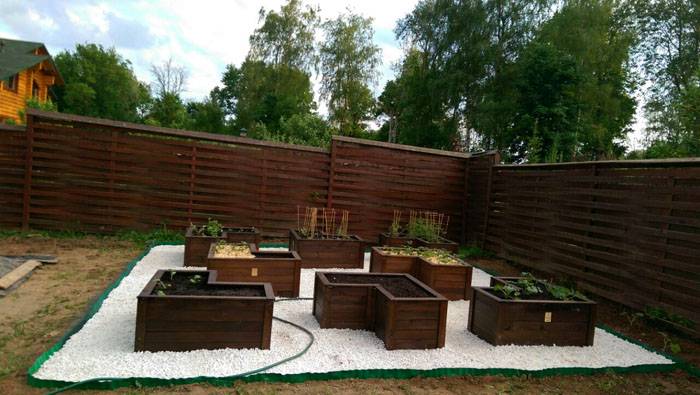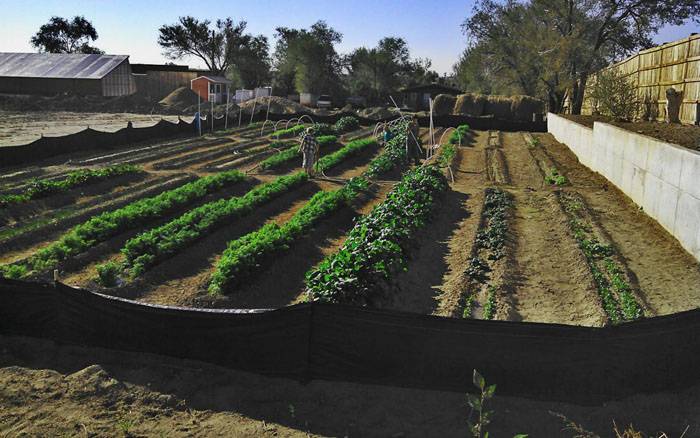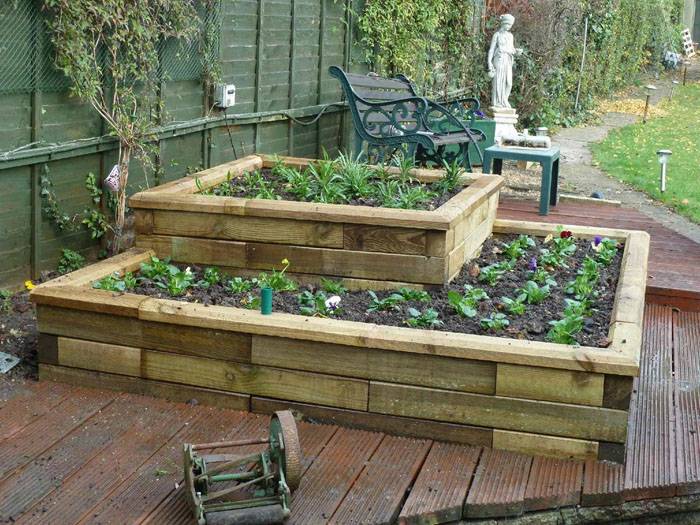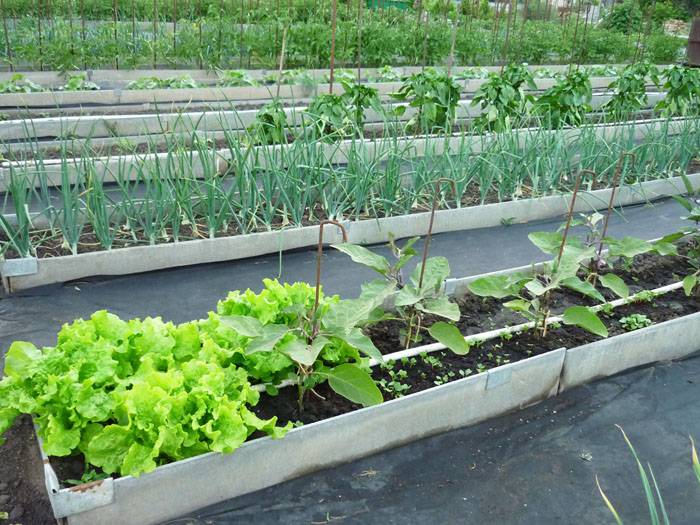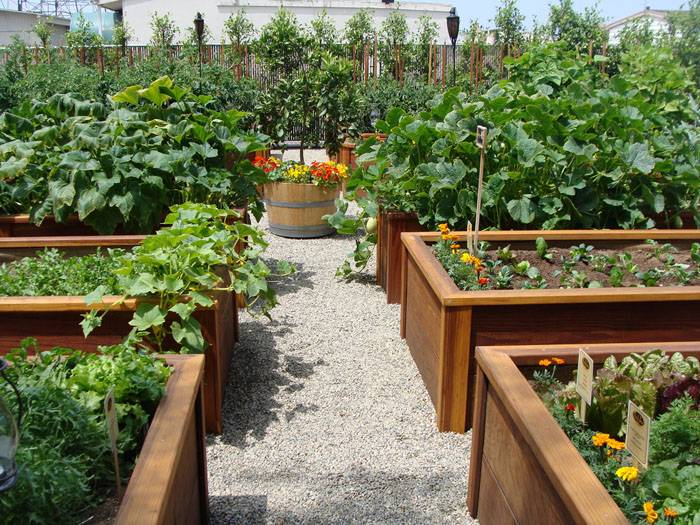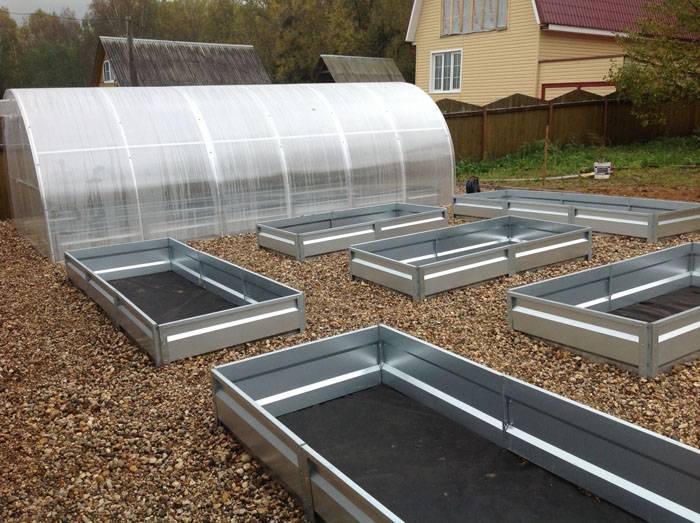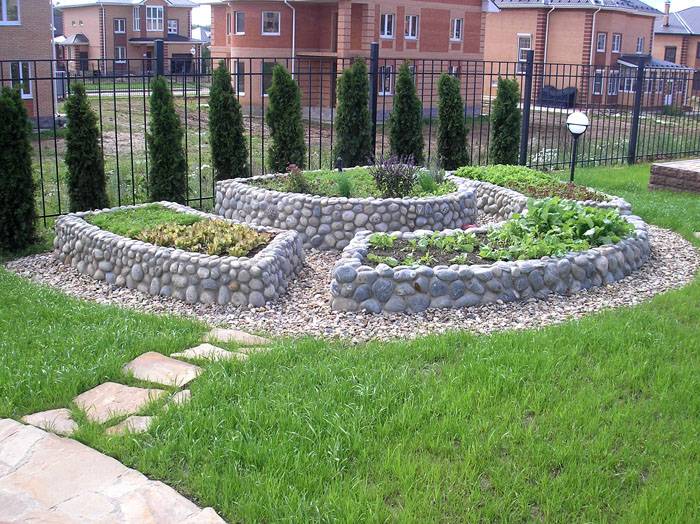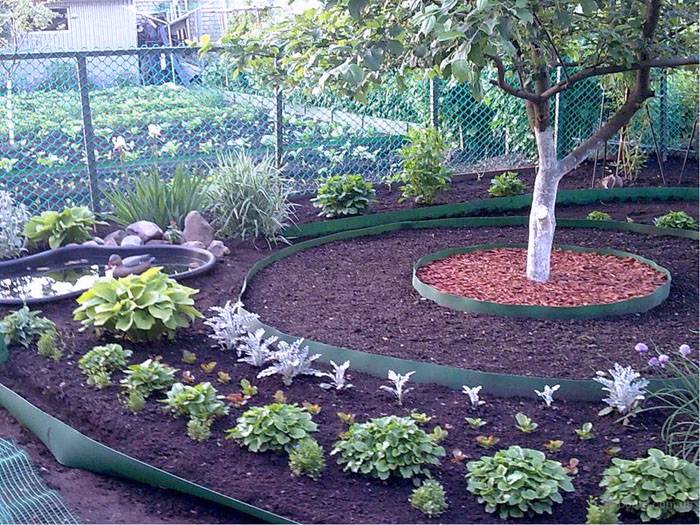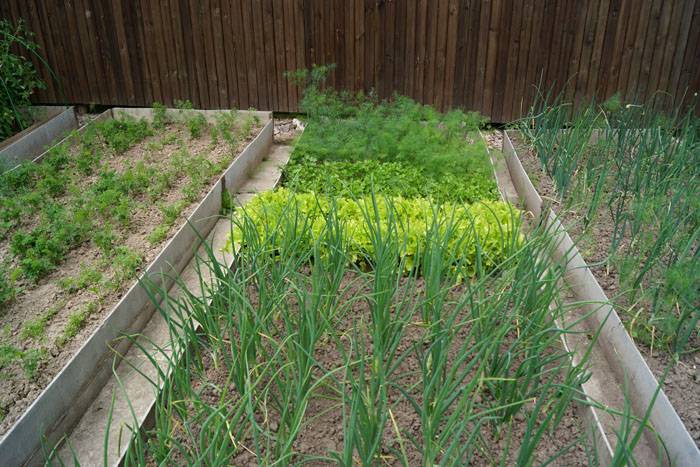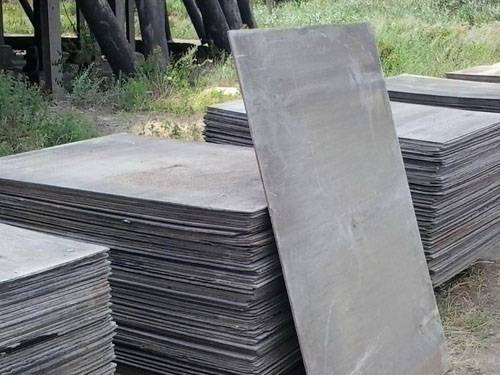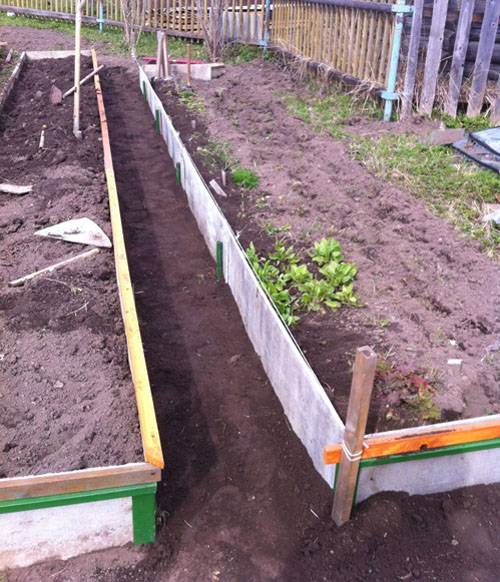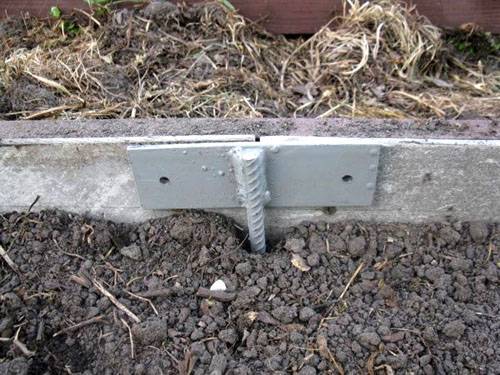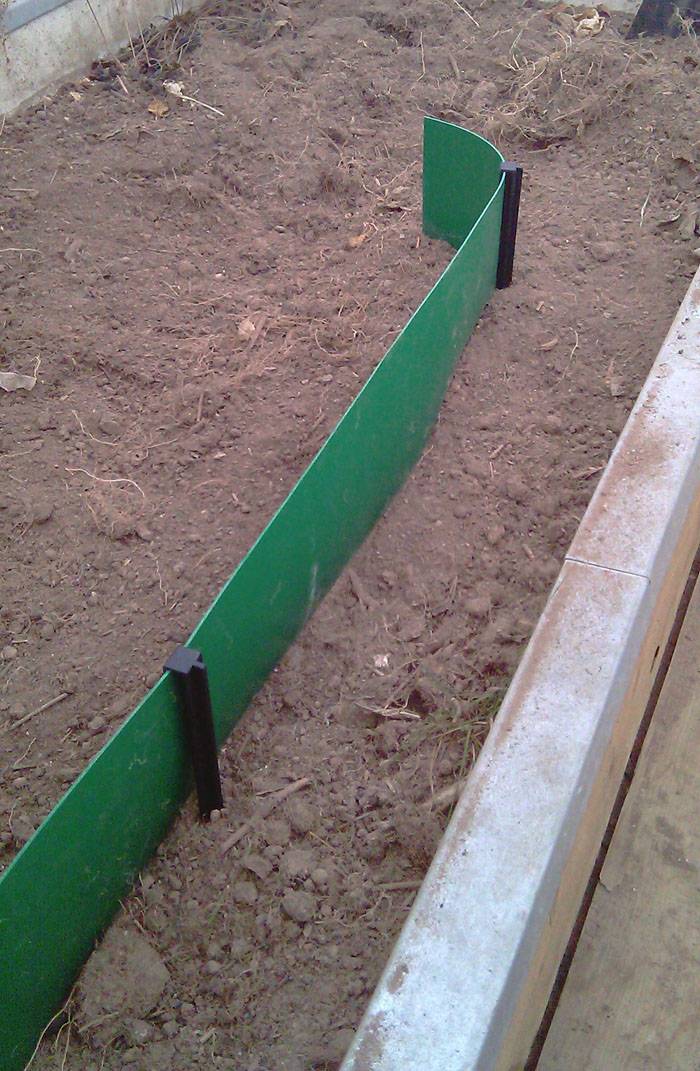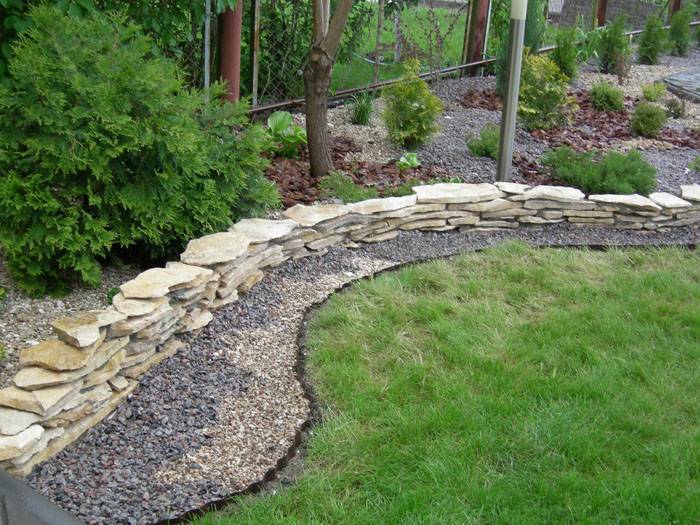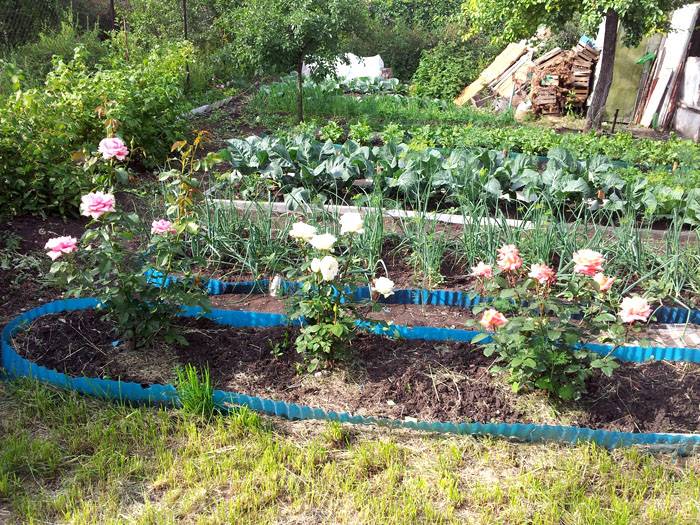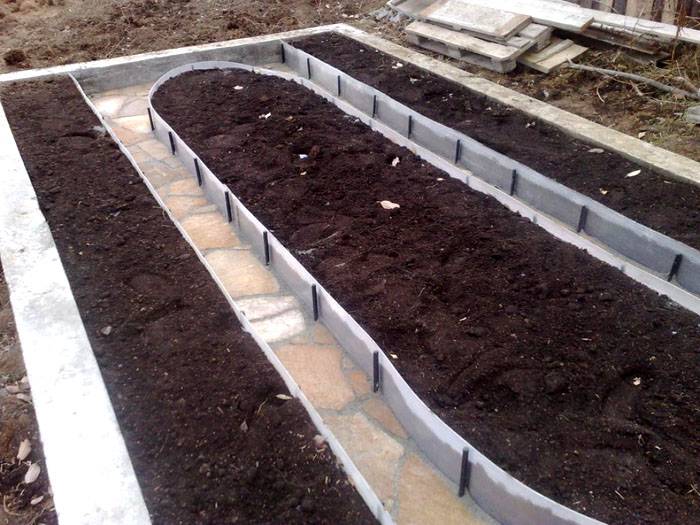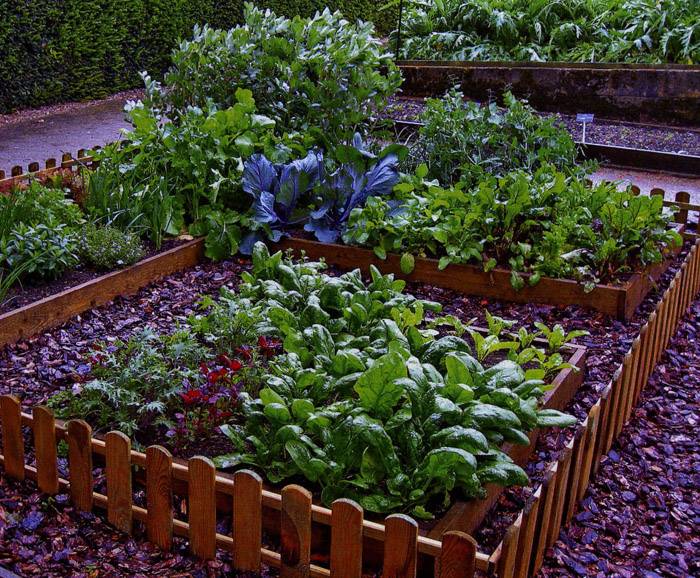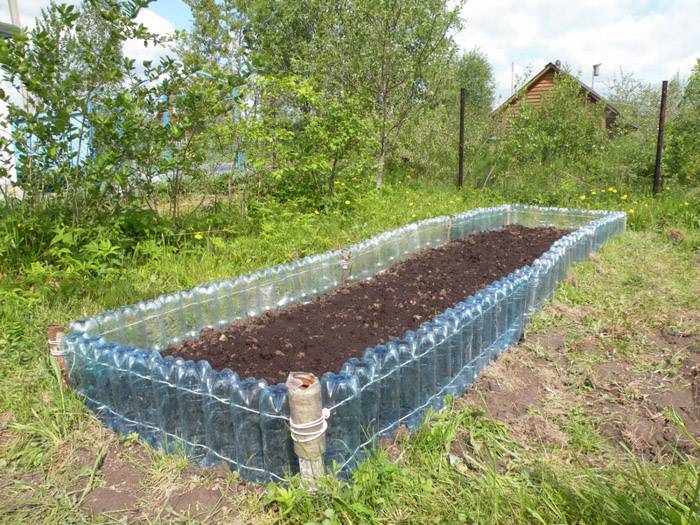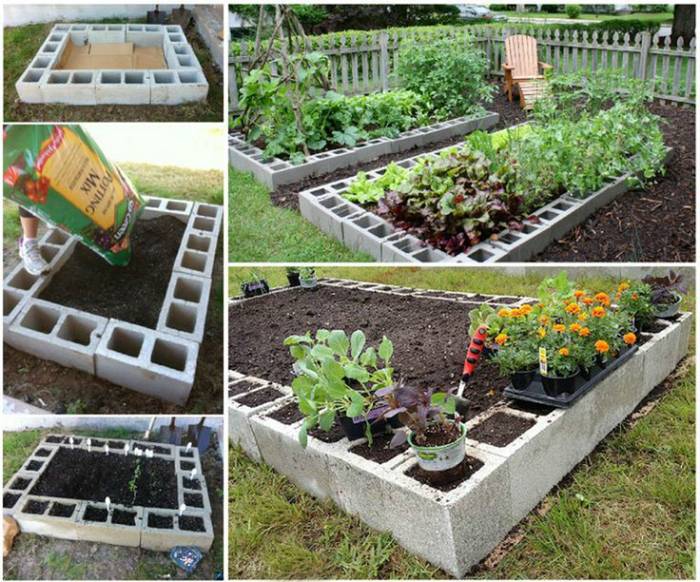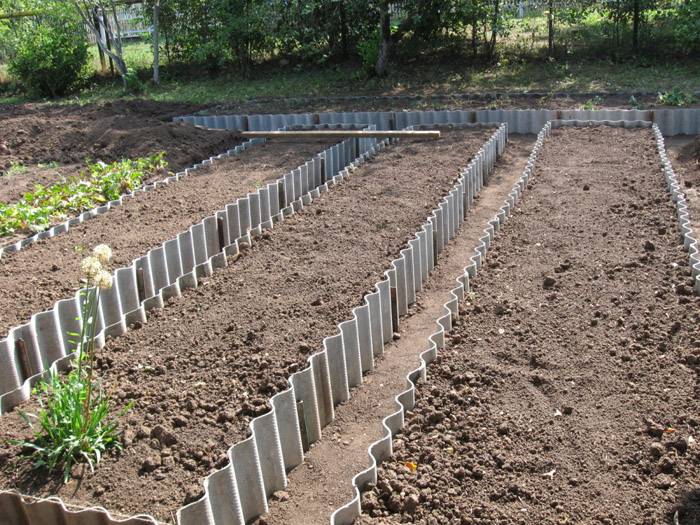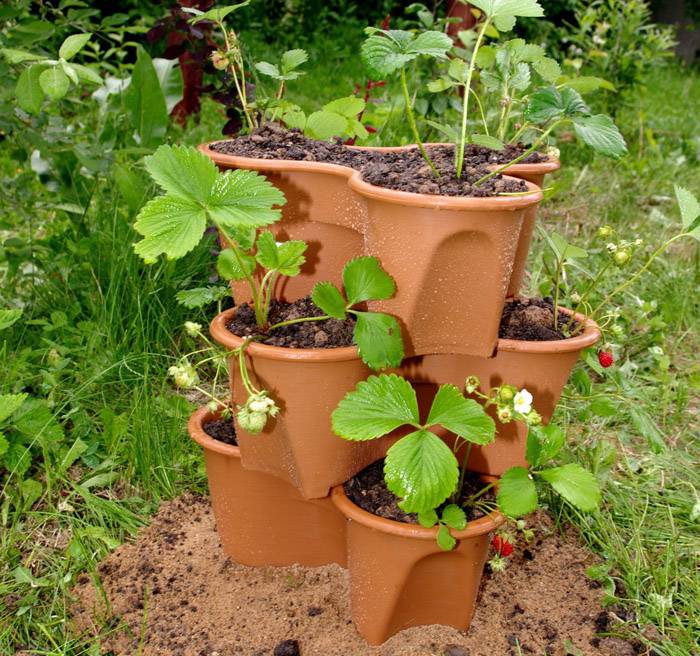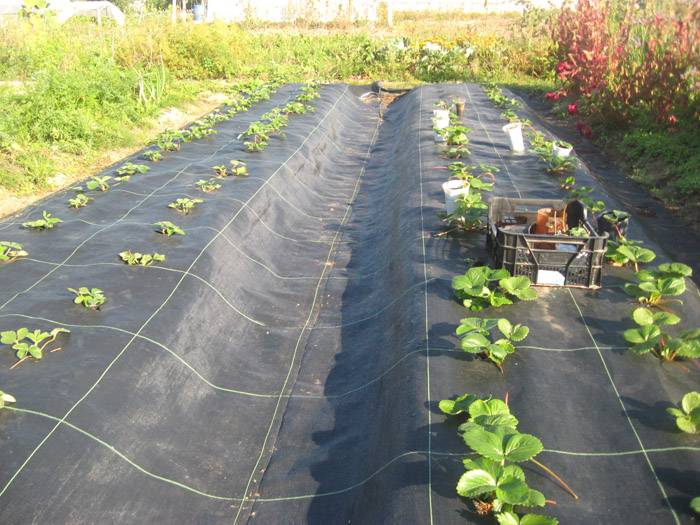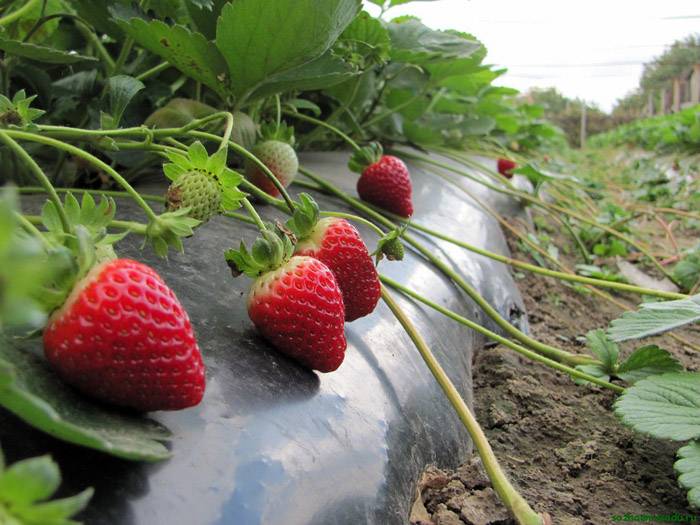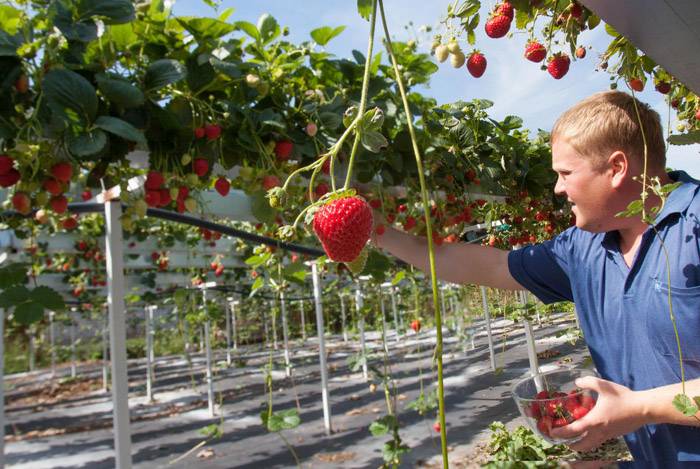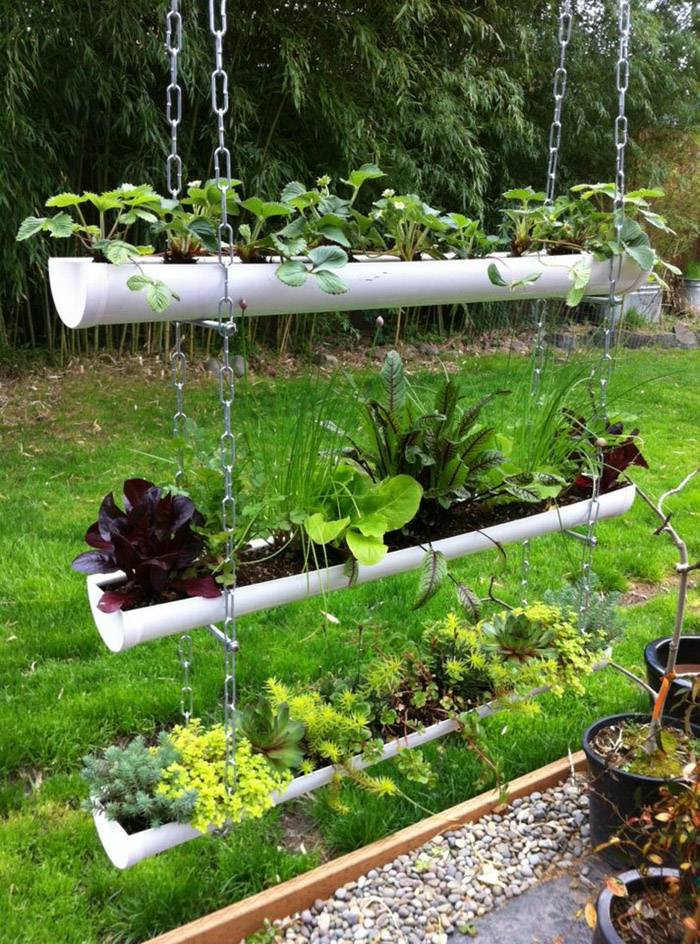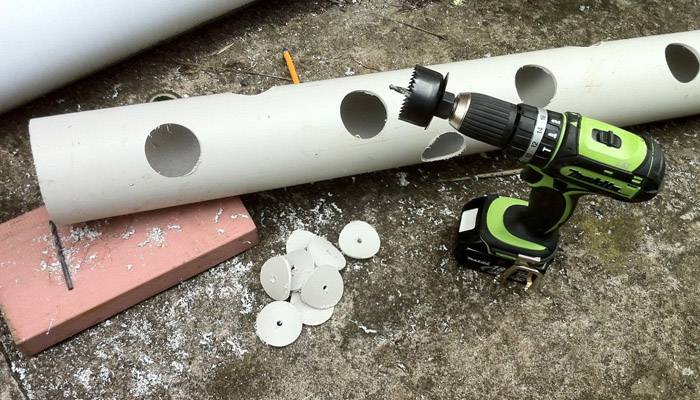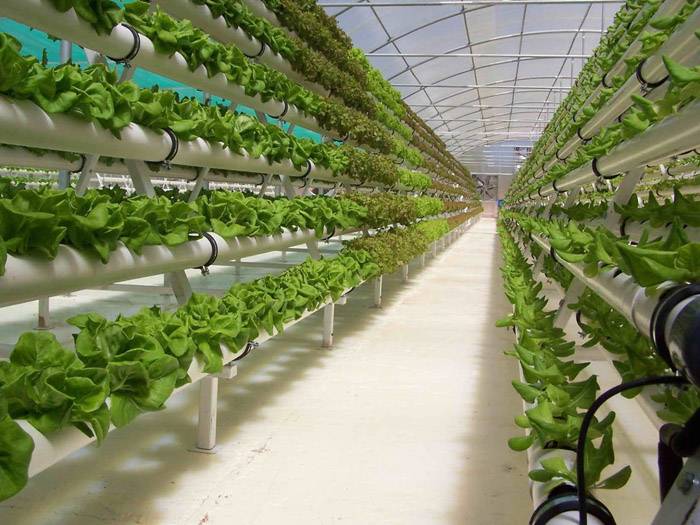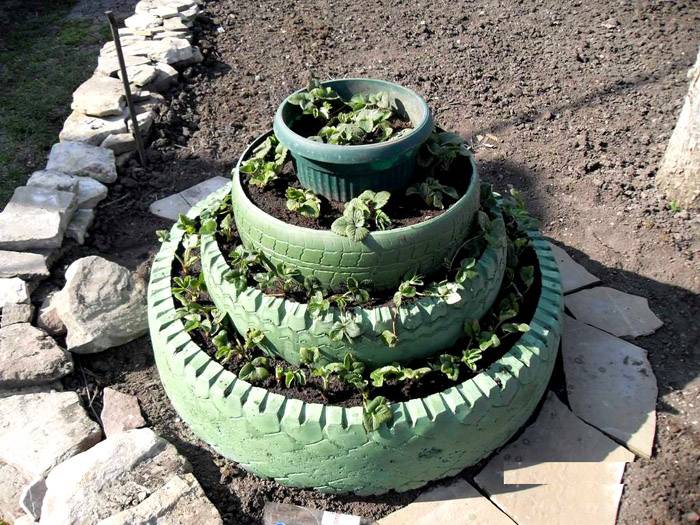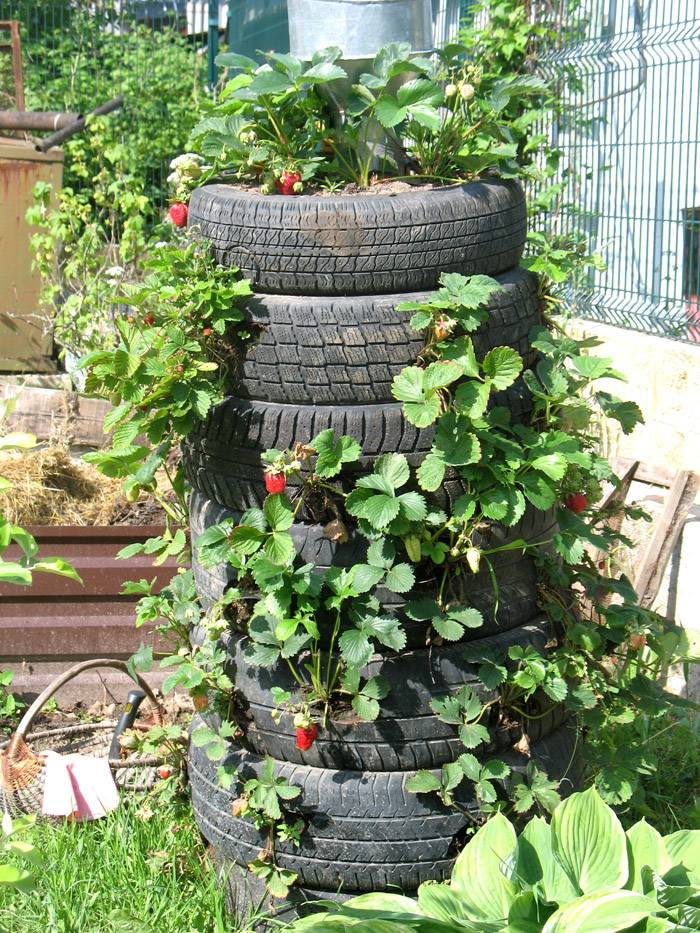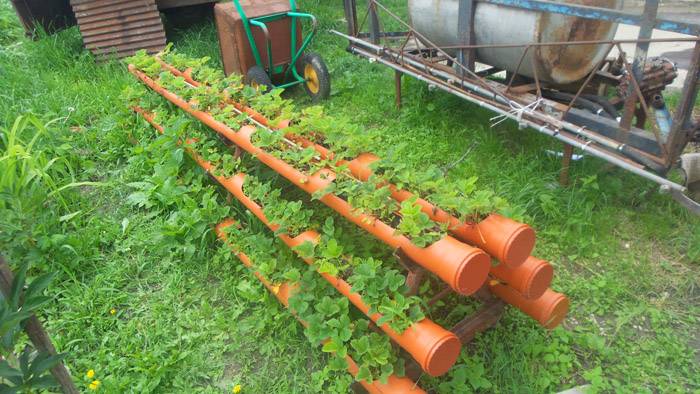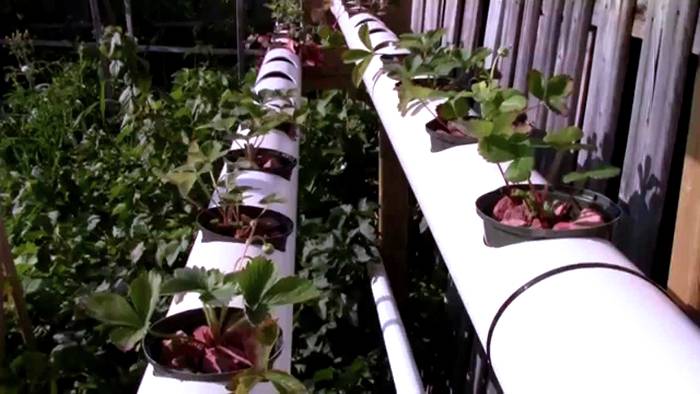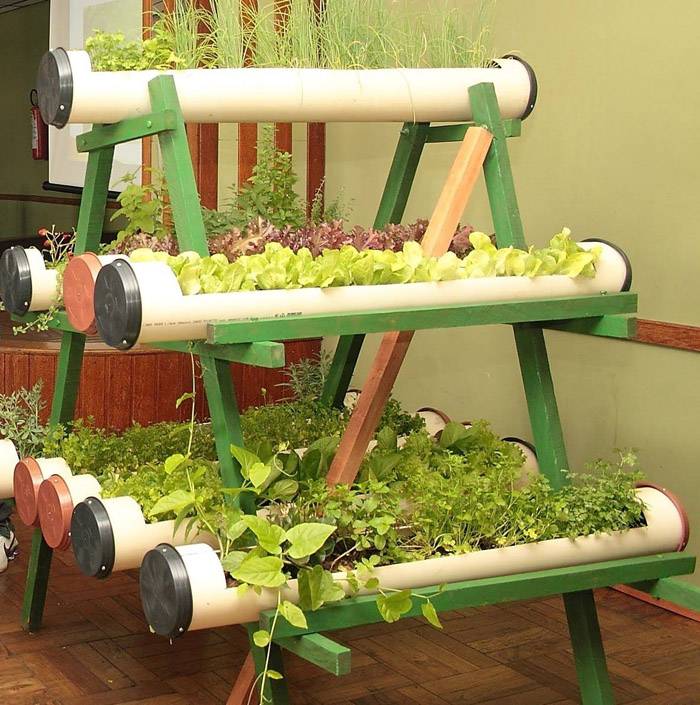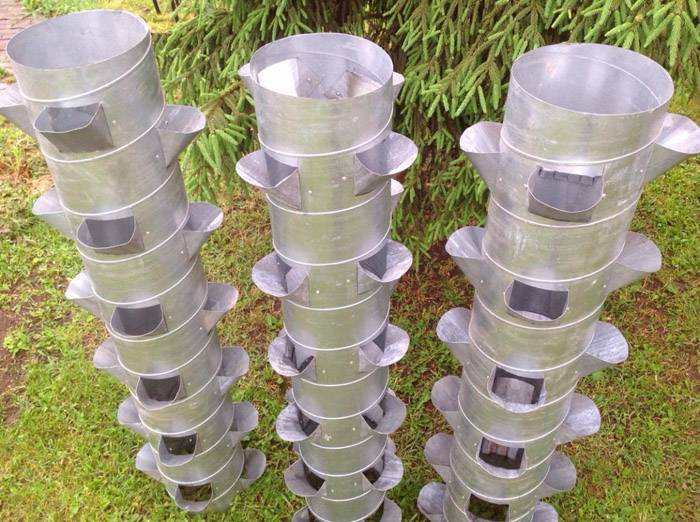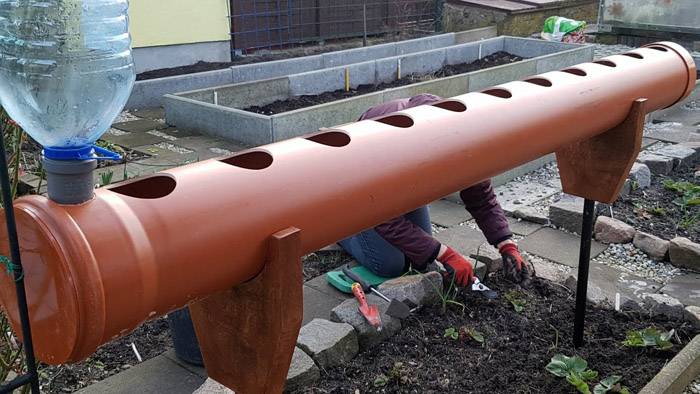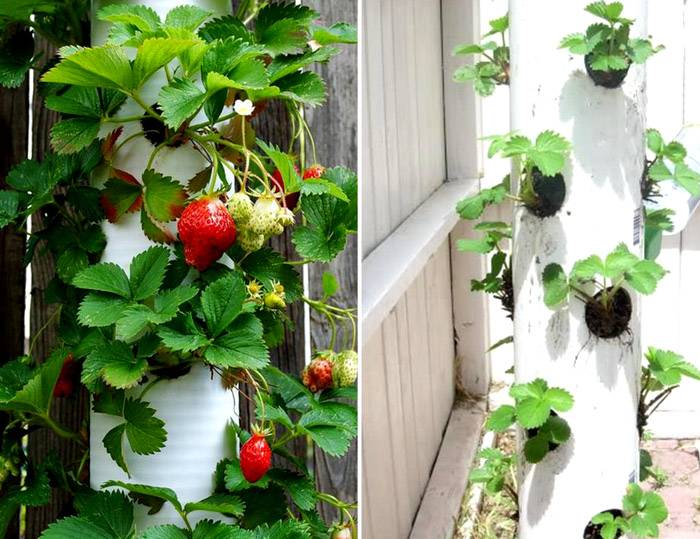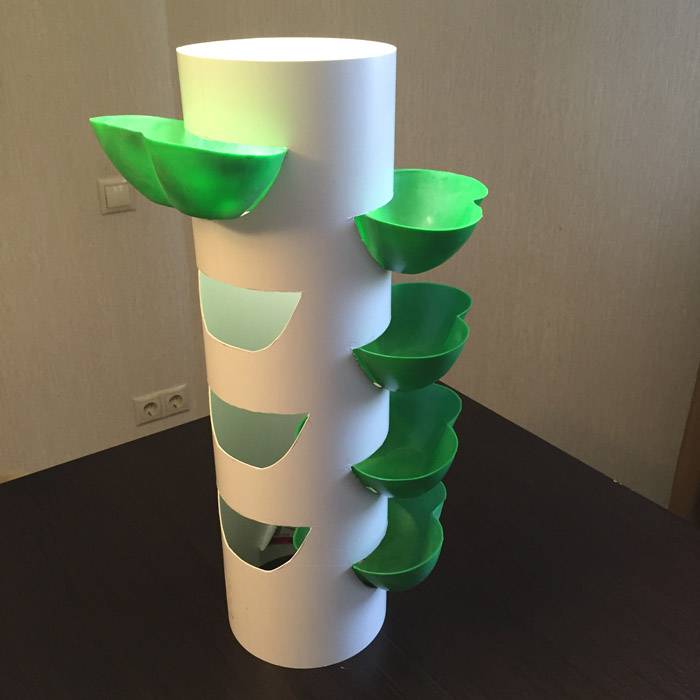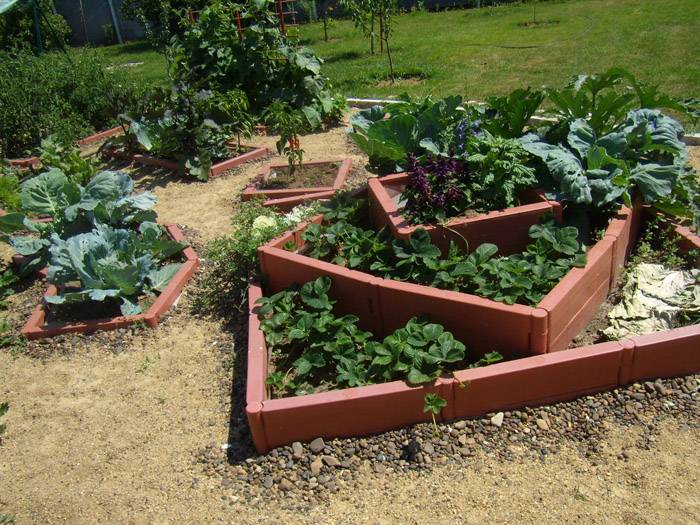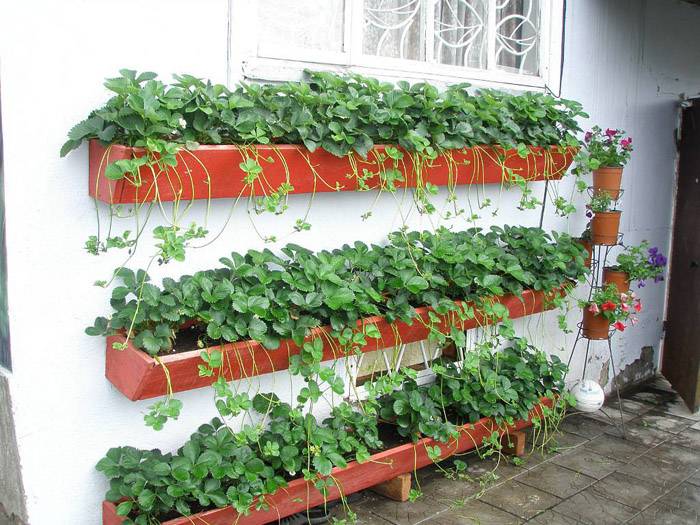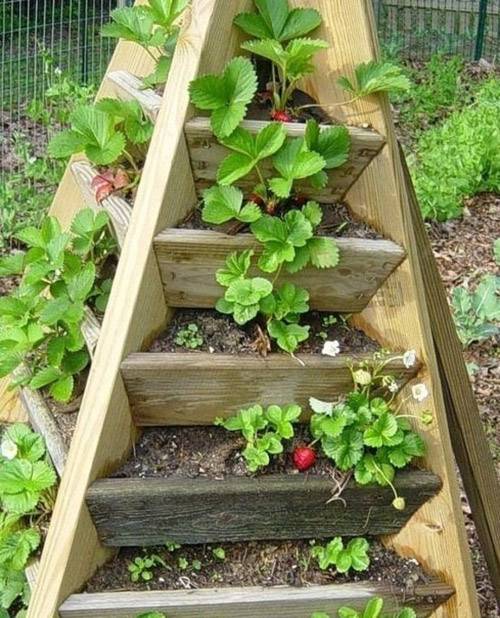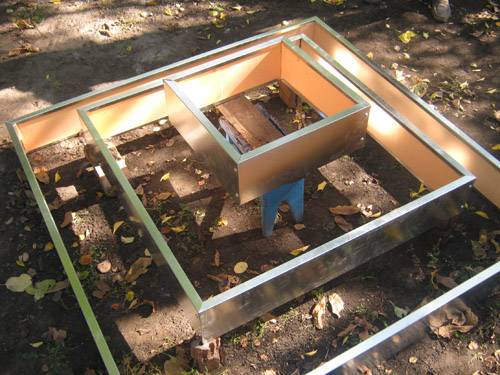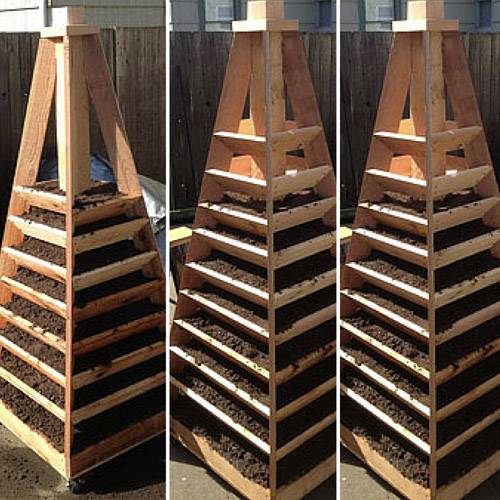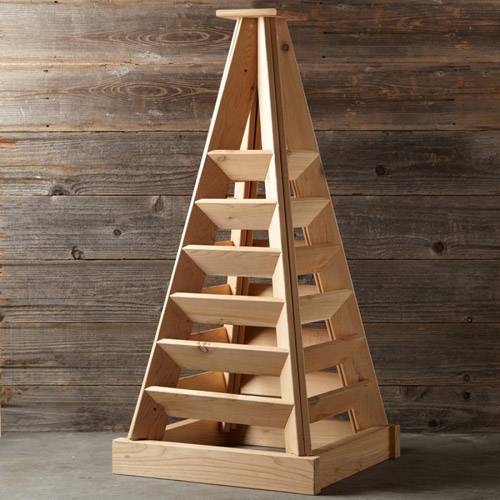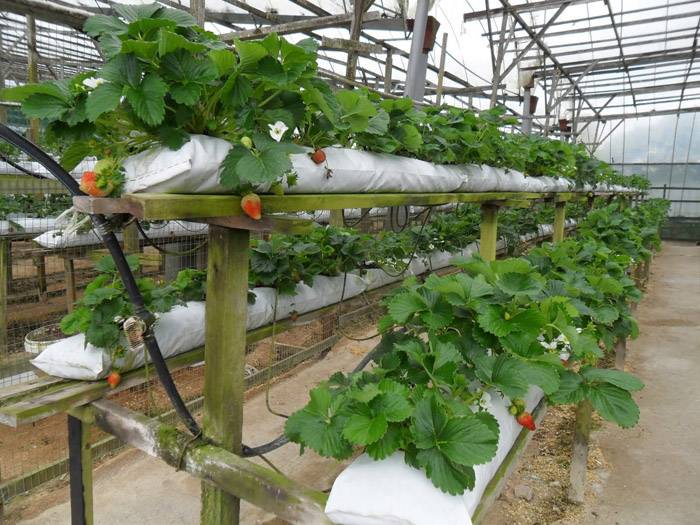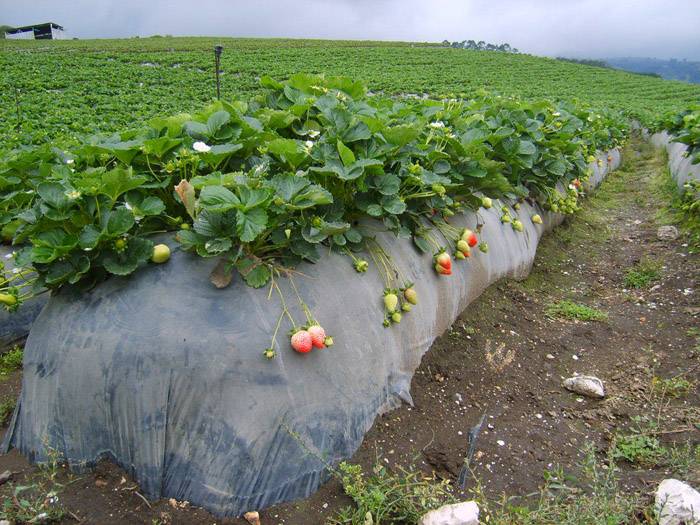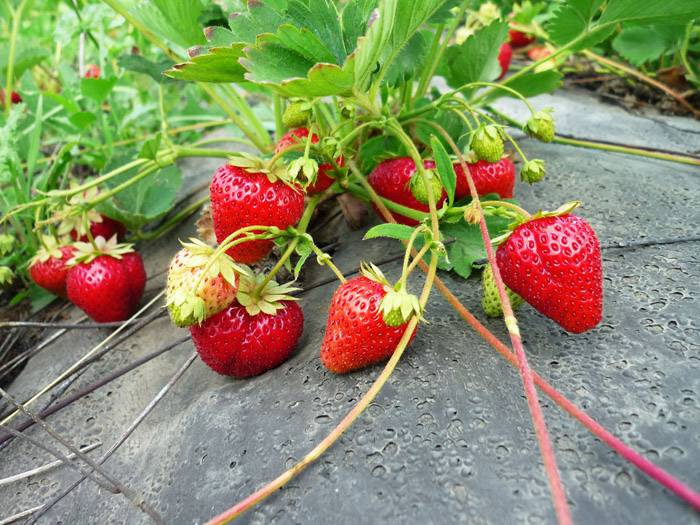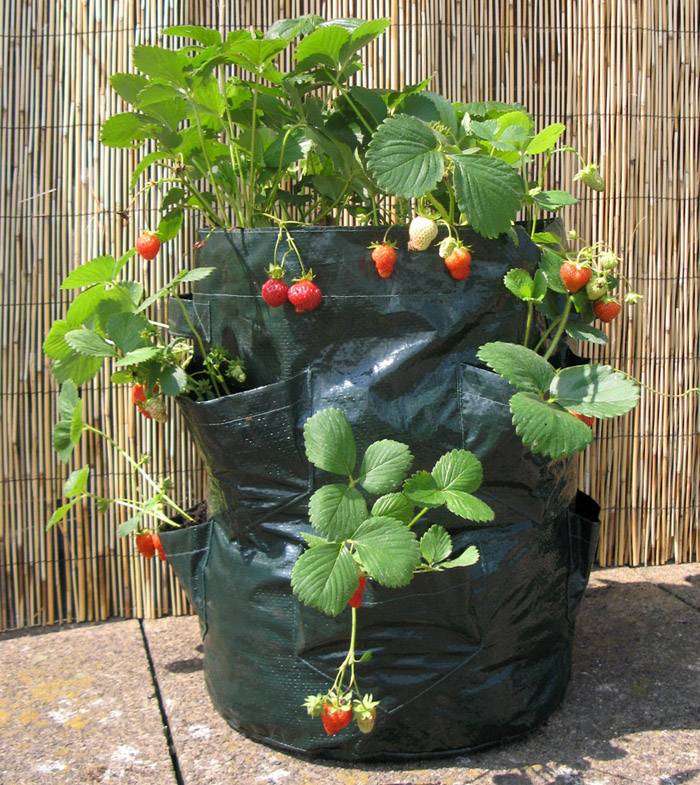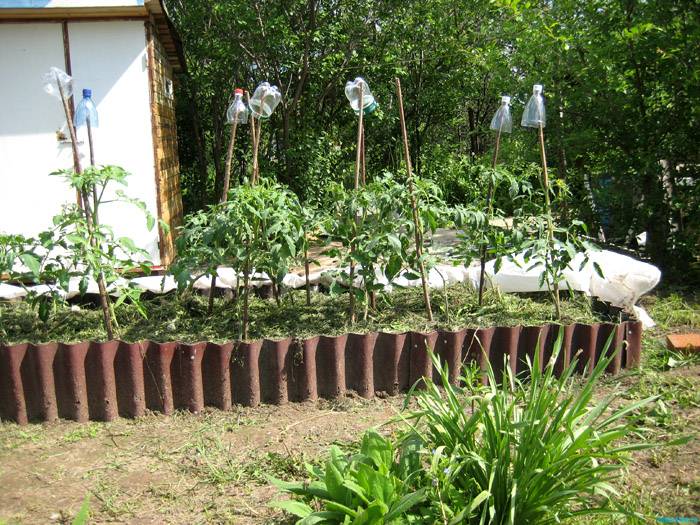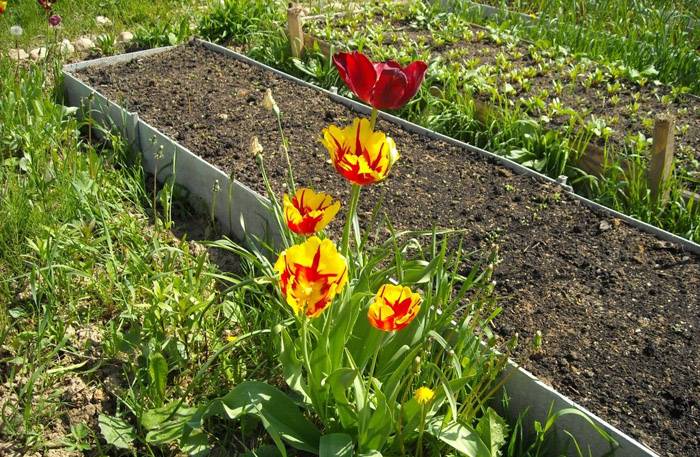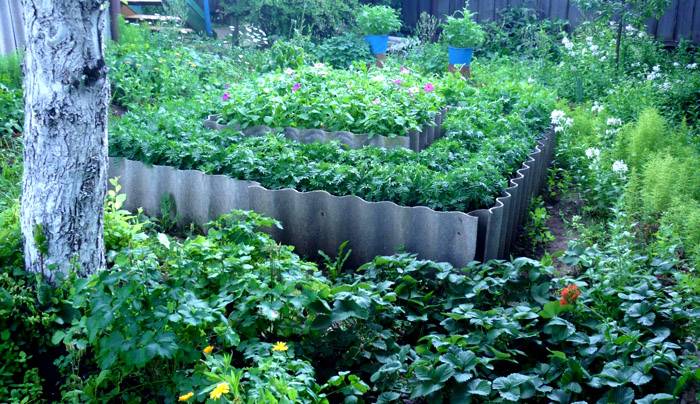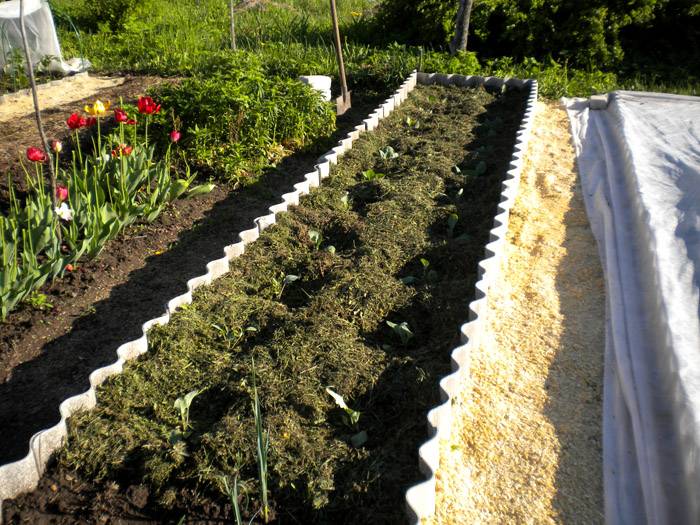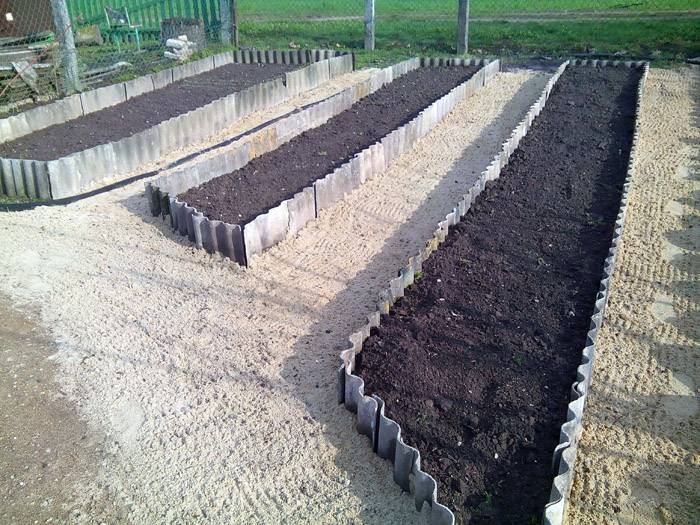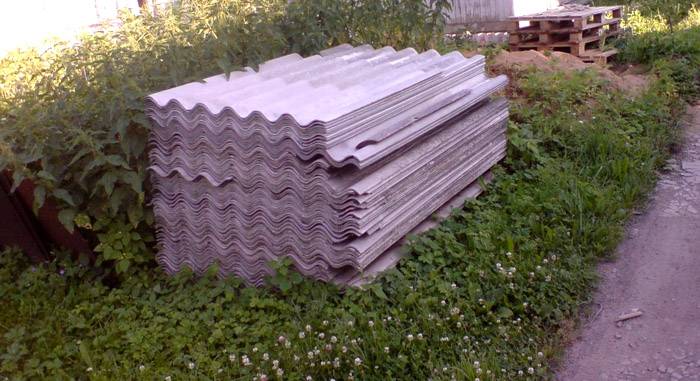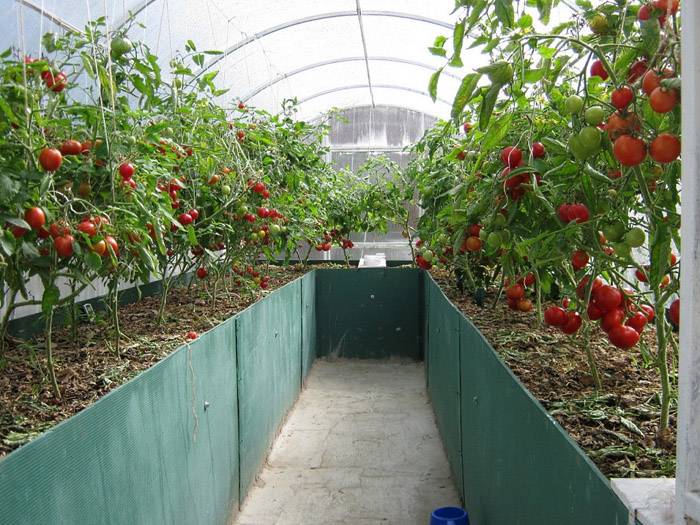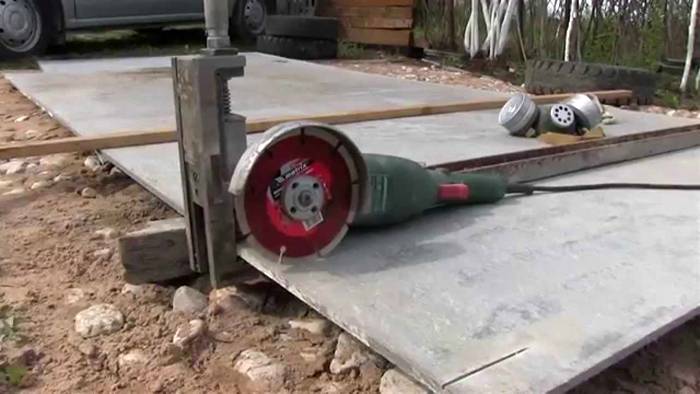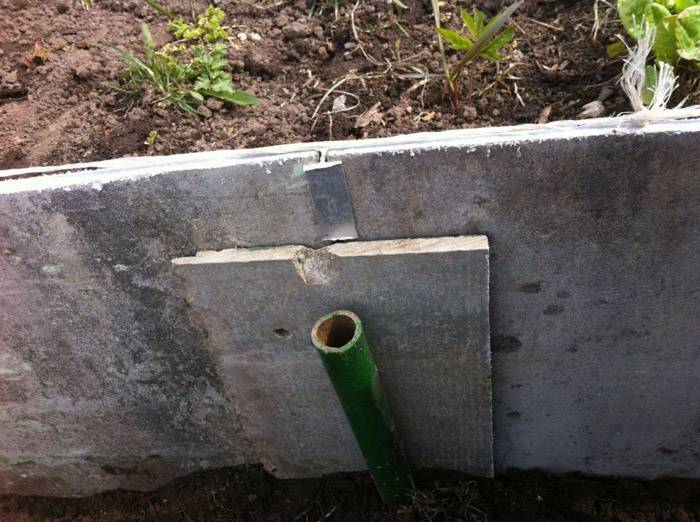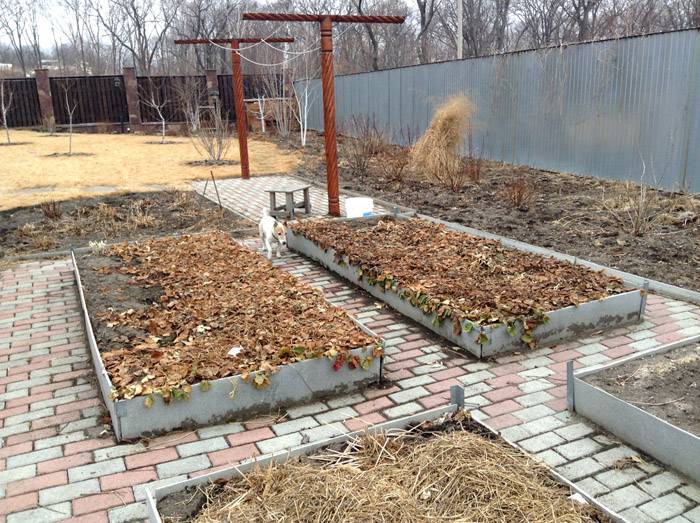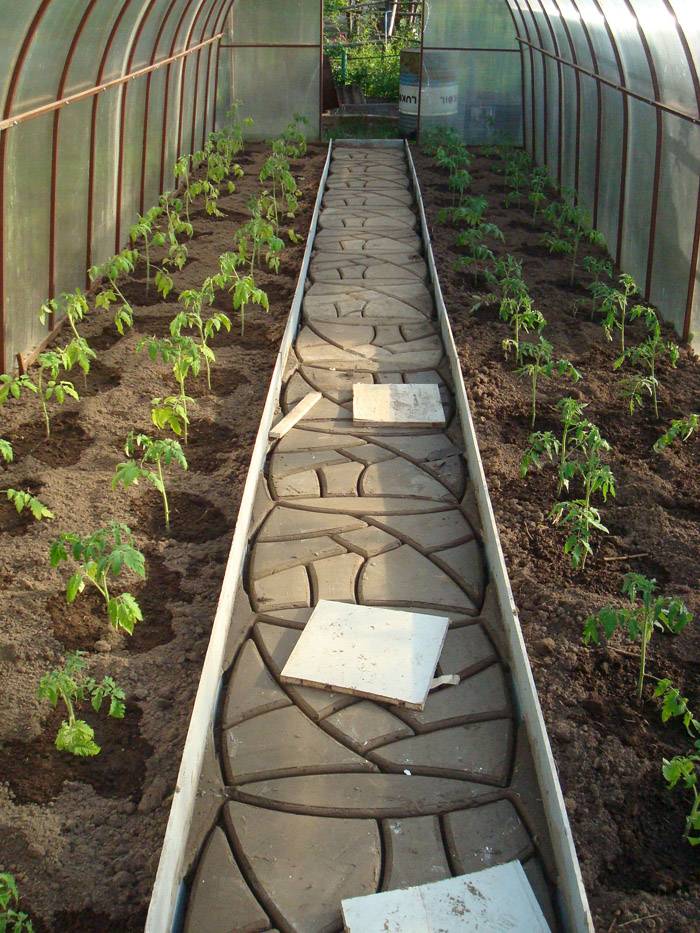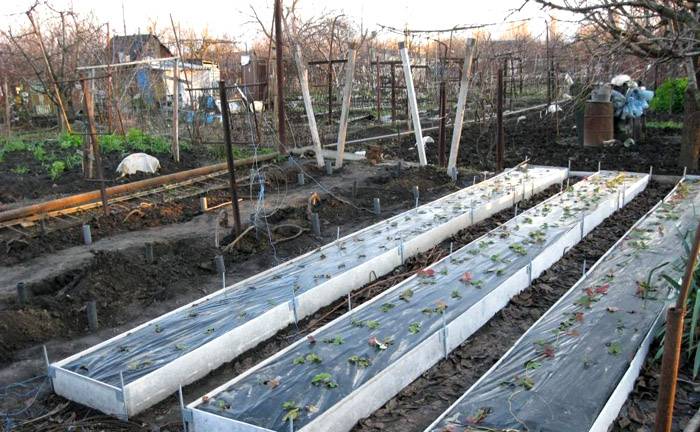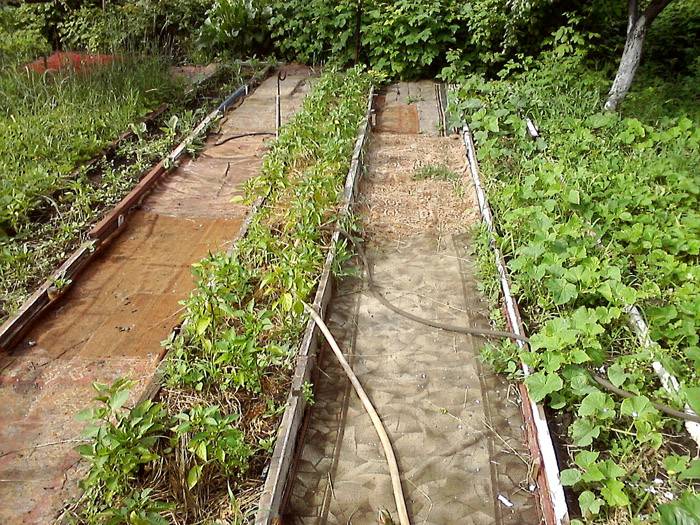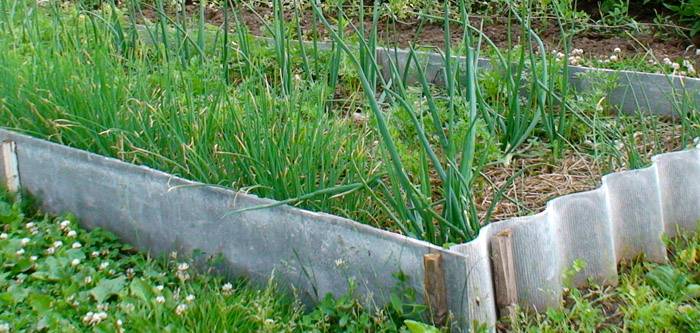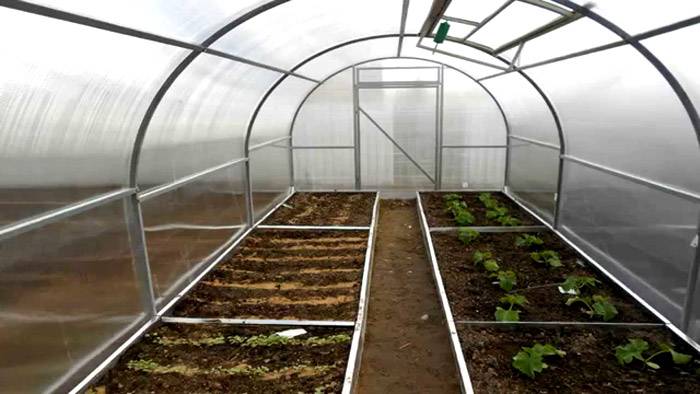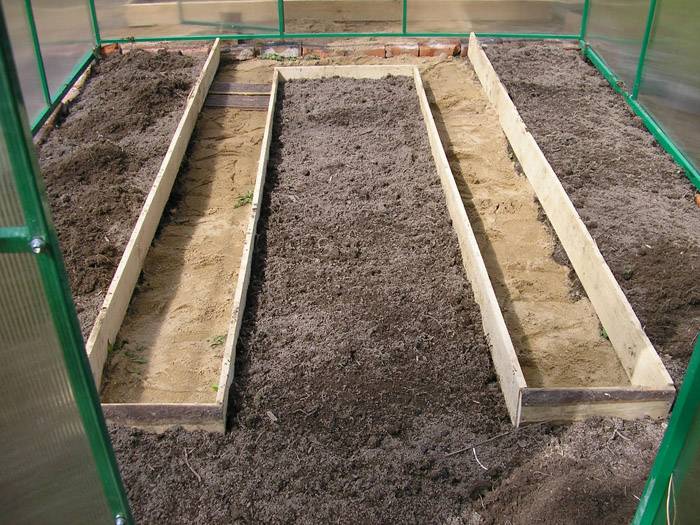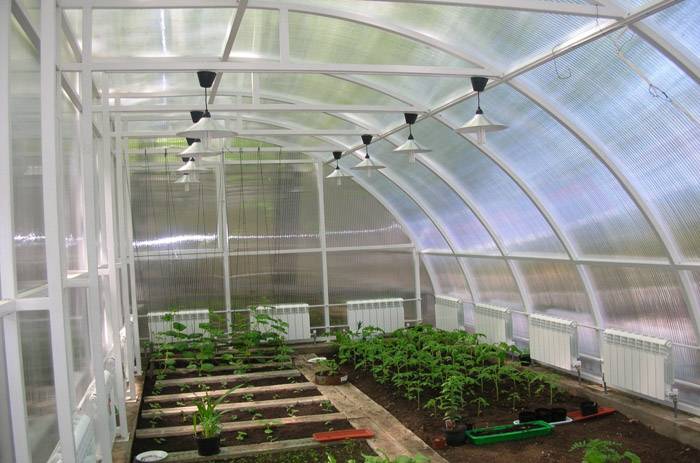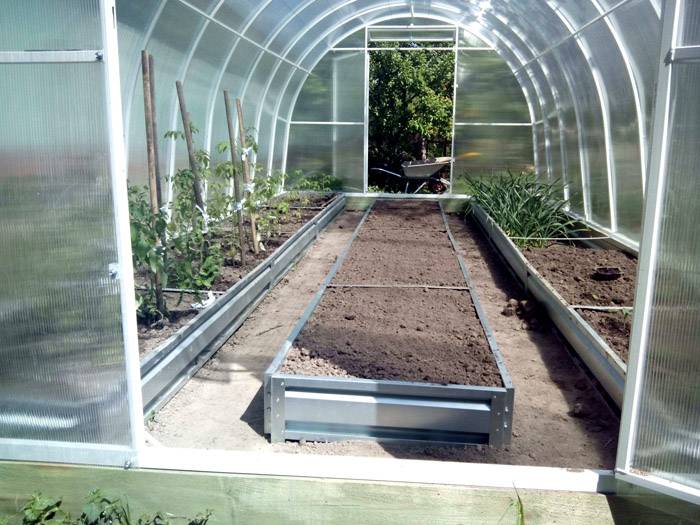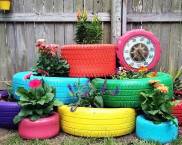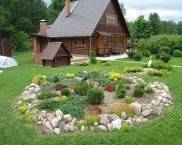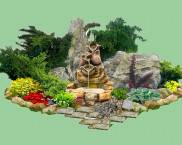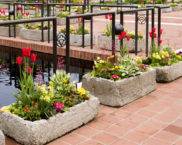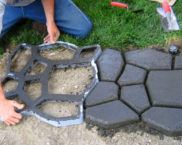How to make beds with your own hands, not like everyone else? Interesting ideas and photo examples
City dwellers love to spend time at dachas, where someone organizes only a recreation area, while someone plants flowers, vegetables and grows fertile trees. Spending several hours a day or a week in the process of cultivating the land, the question arises of how to make the beds with your own hands, not like everyone else. Interesting ideas come to mind of many summer residents and owners of private houses. Consider original photo examples and a few instructions for creating such beauty.
The content of the article
- 1 How to create beds with your own hands is not like everyone else: interesting ideas of ready-made options
- 1.1 Examples of garden design with beds
- 1.2 How to make a garden bed in the country with your own hands with a suitable size
- 1.3 How to equip the beds in the country with your own hands with photo examples
- 1.4 How to make a fence for the beds with your own hands
- 1.5 Diy photos of unusual beds in the country
- 2 Diy photo of strawberry beds: features and examples of creation
- 3 The advantages of do-it-yourself slate beds with photo examples
- 4 How to make beds in a greenhouse: photos of interesting works
- 5 Autumn and spring preparation of the beds: how to make the yield higher
- 6 Few recommendations
How to create beds with your own hands is not like everyone else: interesting ideas of ready-made options
While decorating their garden, many people think about how to create beds with their own hands, not like everyone else. Interesting ideas come to mind, but the process from implementation becomes difficult and not everyone succeeds.
You should not despair at the same time, you can take a ready-made version as a basis, and on its drawings to bring your own original creation to life. Keep in mind that not only the structures themselves will decorate the site, but also the combination of garden paths and the grown crops themselves will be included in the overall landscape design.
Here are some interesting photos of decorating the beds in the garden:
Examples of garden design with beds
Many interesting ideas for do-it-yourself beds are not like everyone else's can be found in the vastness of the global network. Despite the fact that people still associate a vegetable garden with land and small long mounds for planting edible crops, the process of creating a unique vegetable garden can be a fascinating experience.
Making beautiful beds with your own hands using a photo with instructions is not as difficult as it seems at first glance. The main thing is to decide on the selection criteria. For example, for a small plot, vertical structures that take up minimal floor space are a good idea.
When choosing the shape of the planting site, also take into account the dimensions of the entire area that you will set aside for the beds. Avoid choosing round shapes for narrow and long areas. For best seedlings, try to arrange the planting from north to south in din. And if you got land with a slope, it is better to plant vegetables across it to avoid washing off the crop with heavy rains.
How to make a garden bed in the country with your own hands with a suitable size
If you are going to arrange a garden bed in your garden, you should decide on the size in order to plant the maximum number of crops, using the entire area rationally. There are no exact criteria for dimensions, however, it is necessary to make such a place for planting so that it is easy to weed from the path.
The standard size is considered to be 1 m in width, from 1.5 m in length or up to 50 cm in depth. The distance between landings is up to 40 cm, it is quite enough for free passage. In this case, the path is made 30-50 cm below the upper level of the ridge.
There are several types of beds that differ from standard dimensions:
- TO traditional refers to the standard sizes described above.
- Big. In terms of area, such a structure exceeds 12 m². In such open spaces, plants are planted that practically do not need weeding: potatoes, beans or pumpkin.
- Hilly option. Height is from 80 to 100 cm, and there are no requirements for length. To create, the top layer of the soil is cut off and fences are made of metal or chipboard. In the middle of such a structure, a small depression is made, where water accumulates when watering.
- High. For such a design, it is worth choosing sunny areas. It is advisable not to exceed 1.5 m in width. Ridges are different in height, but do not forget that this option needs frequent watering.
- Deep. Instead of a hill, make a trench where you put peat, compost and manure, on top of everything you put soil, the height of which does not exceed 25 cm.
- Narrow vegetable bed. Most commonly used in greenhouses. Also suitable for open ground. In such structures, plants are planted with small growths on top, but a strong root system.
When choosing a garden bed option, it is worth considering the characteristics of the crops that you plan to plant. Some plants prefer moist soil more, so high ridges are rarely chosen for them.
How to equip the beds in the country with your own hands with photo examples
To equip your garden, it is worth considering not only the shape and subtype of the garden itself, but choosing the material for its framing, as well as equipping the paths.Why do fences around the landing site? There are several reasons for this:
- The aesthetic side. Such designs look neater and more interesting.
- Weeds will grow less. For their development, the free area is reduced, and it is much more convenient to weed.
- Ridges do not crumble from rain or watering.
- The soil moisture remains longer after watering.
Important! Choose the right material for making the beds. It must be breathable and not emit toxic substances.
Good options come from:
- flat slate for beds: an inexpensive option that will serve as an additional decor, but do not forget that it is quite fragile;
- wood: natural and easy to install, but short-lived and requires processing from decay;
- galvanized steel with polymer coating: long service life, but it will not be cheap;
- stone or concrete: durability and beauty, but this option carries material costs, and also requires a certain skill in laying;
- curb tape: the easiest and most affordable way of registration.
The paths between the beds can be left as they are, sprinkled with small stones or covered with paving slabs. It depends on the choice of garden decor you choose.
How to make a fence for the beds with your own hands
The simplest options for fences that do not require a lot of time and have an affordable price: flat slate and curb tape. In the second way, you can create any forms for planting fruit crops.
To make an interesting decor on your site, you first need to buy a flat slate for the garden bed. The average cost is from 300 to 500 rubles. depending on the thickness of the material. The classic size of one element: 100 x 150 cm.
The installation of flat slate itself will be reduced to several simple steps:
To make it easier to work, watch the video on the topic:
It is hardly easier to use the borders for the beds with your own hands. The softness of the material allows you to make any shape, and for strength, the material is not only dripped into the trench, but also plastic pegs are used. Here are some interesting photo examples of finished works:
Related article:
Edging tape for garden beds. In the article, we will consider in detail why it is useful, what types of garden curb tapes are on sale and how to install this device correctly?
Diy photos of unusual beds in the country
It is not at all necessary to spend a lot of money on fencing for planting fruit crops; you can use the simplest and most affordable materials that you have left from construction or other work. Often, scraps from boards, bricks or pieces of corrugated slate are used.
Lovers to do everything on their own, as well as to decorate the garden with bizarre shapes, often make do-it-yourself beds from scrap materials. Photos of some of the works are presented below:
Related article:
Do-it-yourself beautiful beds in the country. How to apply a scientific approach and build beautiful beds in the country with your own hands, photos and a description of the processes - in this article.
Diy photo of strawberry beds: features and examples of creation
Strawberries are planted in almost every vegetable garden. Juicy and unpretentious berry is a favorite delicacy of adults and children. But in order for it to really turn out delicious, you need to properly prepare the garden.
Today there is a wide choice of material that allows you to accelerate the growth and productivity of bushes. For example, the price per meter for a spanbond is only about 100 rubles, and such a canvas has many advantages:
- creates unique conditions for berry growth;
- has an excellent ability to pass air and water;
- does not allow weeds to develop;
- the soil under the canvas warms up faster;
- excess whiskers do not take root, and slugs are practically absent.
If you do not want to spend money even on such a simple and convenient material, you can make beds from plastic pipes. Here are some interesting photo examples:
Interesting DIY strawberry beds from car tires
When coming up with an option suitable for planting a delicious berry, various materials at hand come to mind. Including tire beds for strawberries. Moreover, you can create a unique vertical structure that takes up little space in the garden and gives a large harvest.
For work, the tires of the right size themselves, a chisel, a wooden block and soil with seedlings will be useful. Additional casing is not required, as the tires have a metal cord that provides proper structural strength.
The seedling holes are made with a chisel, and the tire itself can be put on the block. Make a few holes and the simplest design is ready. Here is a video on one of the ways to create.
Video: we grow strawberries in tires
Instructions on how to make a strawberry bed from a pipe with photo examples
Planting strawberries in a tube (horizontally) is a common option in areas with little free space. Moreover, the material itself can be both metal and PVC. Here are some fun examples:
You can even use a sewer pipe for your strawberry bed. Let's take a closer look at how to make a design for a delicious berry:
- Prepare two pipes with different diameters, while the thin ones should be 20 cm shorter than the thick ones.
- In the large one, drill holes with a large diameter (7 cm) at a distance of 15 cm.And in the small one, three rows of holes with a diameter of 0.5-1 cm and an interval of 8-10 cm are made.
When the preparatory work is completed, assemble the structure. To do this, place plugs on the pipes. You deepen the thick one into the ground, and a small irrigation pipe is attached to it in the center. The soil is filled up, and bushes are planted. To make it clear, watch the video on the topic:
Interesting designs of vertical beds for strawberries from plastic pipes. Here are some photo examples:
How to make multi-tiered designs for strawberry beds with your own hands
Modern materials, as well as improvised means, allow not only making high beds in the country do it yourself, but from the photo recreate real pyramids with beautiful bright bunches of strawberries. And also to make multi-level "houses" for flowers.
Making a pyramid for growing strawberries on your own is not so difficult. You can use various materials for the fence: wood, metal, plastic. And also all kinds of improvised means:
- flower pots;
- tires from cars;
- cutting pipes of different diameters;
- boxes of vegetables and fruits.
There are no exact criteria for the shape of the base. You can make it round, square, rectangular, polygonal, and even wavy. Consider an easy way to make a multi-tiered strawberry bed:
To make it easier and faster to work, watch the video on the topic:
Photo of beds for strawberries from bags
Vertical strawberry beds are ideal for small areas. They can be purchased ready-made in the store or made yourself. And the second way is a real flight of fantasy. In addition to the considered methods of erecting beds from pipes, tires and wood, you can make a unique decor with fruitful bushes from bags.
The process of growing strawberries in bags is no different from a classic or vertical bed, but very interesting options for creating beds are not like everyone else's.
The advantages of do-it-yourself slate beds with photo examples
The use of flat slate for beds has been known for a long time. Every gardener has seen such designs at least once. The material for the sides has a number of advantages:
- durability due to the absence of corrosion and decay processes;
- looks nice and neat;
- easy to mount high structures, and even multi-level options;
- affordable cost;
- is available for sale in any city or online store.
Despite the ease of installation and undemanding additional processing, slate has negative aspects that must be taken into account when choosing fences for planting strawberries:
- gets very hot in the sun, therefore, the beds should be watered more often;
- exposure to mechanical damage: if accidentally hit with a shovel or cart, the slate will crack.
But from the wavy material, very neat and beautiful beds are obtained:
How to make wavy slate beds with your own hands
From the photo above, it can be seen that creating a bed of corrugated slate is not necessarily even and rectangular. You can make structures in several levels or bevel corners, choosing the best option for your site.
Sometimes slate scraps left after the roof are used. This is the cheapest option for arranging a garden, since it does not bear additional costs, but there are inconveniences of working with different pieces.The easiest way is to buy corrugated slate sheets of the same thickness and length. Moreover, the average price for them varies between 200-300 rubles. for 7-8 waves. Average dimensions: length - 1.75 m, width - 1.13 m.
To lay such a fence in the ground, it is enough to dig a small trench along the perimeter of the future ridge. Put the slate in straight lines in this hole, about half the total height, and dig in with earth. To understand the sequence of actions, watch the video on the topic:
Features of do-it-yourself flat slate beds
Many summer residents prefer to make the fencing of the beds with slate, as it is affordable and simple. And also no specific skills and abilities are required, as is the case with laying a stone curb.
At the same time, such a practical and harmless material has several recommendations for installation as a fence for flower beds or beds:
- For convenience, a full sheet of flat slate is sawn in half or divided into parts of 1 and 0.75 m.
- Elements should be fixed to each other using metal corners, painted with a special varnish against corrosion. This prevents the ridge from spreading.
- If you want to change the color of the material used, do it in advance, and not after installation.
And also observe safety precautions and carry out the installation with construction gloves so as not to injure your hands on sharp corners or screws. As a result, you can get a beautiful vegetable garden that stands out against the background of neighboring beds:
Price for slate for beds
If you don't have any pieces left over from your roof repair, you can buy slate strips for your garden beds. The price for them is different, depending on the thickness of the material:
| Name | Dimensions, mm | Cost, rub. |
|---|---|---|
| Strips for beds in a set of 400 pcs, "Stroy base", Moscow | 1750*240*6 | 88 |
| A set of 400 pieces, PA "KSM", Moscow. | 1500*300*6 | 97 |
| TD Petrostroykomplekt, St. Petersburg. 400 pcs in the package. | 1500*300*10 | 138 |
Pre-cut strips are easier to work with as they eliminate the need for cutting. At the same time, you can find very cheap options with and without delivery, as well as order a kit through online stores.
To calculate the required amount, decide in advance how many and which beds you plan to make. It is better to take material with a margin, in case of breakdown during transportation or installation.
The installation of flat slate for the beds itself does not take much time. Watch the video instructions to understand all the stages of work:
How to make beds in a greenhouse: photos of interesting works
The greenhouse is the place where summer residents like to plant heat-loving fruit-bearing plants. In them you can see peppers, tomatoes, cucumbers and much more. Some equip the area for a greenhouse or insulate the structure so as to get a harvest all year round.
For whatever purpose the greenhouse is used, this is a small space, if you do not take into account the commercial options, where you need to arrange several beds.
Advice! Try to think in advance how many plants will be placed in the greenhouse in order to calculate the number and width of the beds.
Curbs that protect fertile land from creeping are collected from a wide variety of materials. There are beautiful creations made of wood or neat metal structures, and curb tape and improvised means are also applicable. Here are several options for arranging a greenhouse:
Related article:
DIY polycarbonate greenhouse. Drawings, types of structures, step-by-step construction and much more in a separate publication of our portal.
A variant of the successful arrangement of the beds in the greenhouse 6x3 with a photo
There are many design options, one of the most common is 3x6 greenhouses. How to arrange the beds in a long and narrow space is a question that worries many. There are several general options for the location of landing sites in a greenhouse:
- Two large ridges with longitudinal and transverse passages. Less drop off space but easy access for thorough planting maintenance.
- Long wide two beds along the walls of the greenhouse. In the middle there is a passage with a width of 50-70 cm. This arrangement allows you to plant different crops, adjusting the distance between them, and take care of them calmly.
- Three identical parallel ridges. Usually the structures are narrow, making it easy to weed the entire area around the plants.
- There is a wide landing site in the center, and narrow along the walls. It is easy to maintain, but gives a little useful area for plants.
When choosing the location of planting sites in greenhouses, keep in mind that the beds near the walls should not be more than 1 m wide. And the dimensions of the central one cannot exceed 3 m. This is due to the need for free weeding and loosening of the soil.
How to make a garden bed in a greenhouse 3x6: a photo of practical ways
Most often, gardeners opt for a large ridge in the middle and small small ones on the sides. This is the best way to plant several varieties of plants in one greenhouse so that they do not interfere with each other's growth and fruiting.
If you opted for a 3-meter-wide bed in the greenhouse, then place it exactly in the center, leaving enough space for passage. The path can be covered with small pebbles or covered with foil so that unnecessary weeds do not germinate.
It is not difficult to make a bed with a width of 3 meters on your own. First, you need to decide on the material of manufacture. And then dig a small trench around the perimeter and deepen the structure of the tour. Be sure to tamp the soil from above.
It is worth making a layer of organic fertilizers under the soil and laying drainage to prevent waterlogging of the soil. Here is a video example of how to redo the beds and make 3 narrow identical stripes:
Do-it-yourself non-standard garden beds in the greenhouse
Traditional designs are not suitable for all regions. For example, in the northern regions, where snow can fall even at the beginning of summer, it is necessary to mount a warm bed in the greenhouse. It's easy to make it with your own hands, the main thing is to choose the appropriate option:
- Internal heating using an electric cable. The temperature inside the greenhouse and in the soil can be precisely controlled.
- Water heating. Pipes are laid under the soil layer and connected to the heating system of the house or a separate boiler is installed.
- Natural material. Components are selected depending on the type of soil and stacked on top for a natural greenhouse effect. Files, dense fabric, leaves collected from autumn, humus and much more are used.
When there is no need for heating, since the greenhouse is located in a warm or temperate climatic zone, other unusual options for planting plants are used. For example, you can arrange vertical placement of beds in a greenhouse. In this case, it all depends on the imagination of the author and the crops for planting.
Below are beautiful photos of the beds in the greenhouse, which you can recreate on your own:
Autumn and spring preparation of the beds: how to make the yield higher
Professional gardeners know about the need to prepare any soil in fall and spring. Such prevention prevents large weed growth and increases yields.
First of all, the area for planting plants is dug up. Moreover, in the fall, this is done as late as possible: almost before the onset of frost, and large clods of earth are left to freeze the roots of weeds and pests. And in the spring, on the contrary, they are loosened to enrich the soil with oxygen and quickly dry out after a snowy pore.If there are perennial fruitful shrubs on the site, then the need for wrapping for the winter depends on the planted variety. For example, girlish grapes do not need insulation.
Important! For any crops and plants that will decorate the garden or be useful, it is worth following the individual care recommendations.
Let us consider in more detail the features of soil preparation for winter and spring planting.
Spring preparation of beds for planting: basic recommendations
Spring is the most active period in the life of any summer resident and owner of a vegetable garden near the house. Seedlings are already growing on the window, which very soon should be transferred to open ground or a greenhouse. But you cannot simply "poke" the plants into the ground, otherwise they will die or not bring the desired harvest. That is why a lot of time is allotted to spring soil preparation.
There are general guidelines that are suitable for all crops:
- The soil should be loose. For this, a vegetable garden and a garden are dug up. On large areas they use cultivators and walk-behind tractorsto make the work process easier. In modest gardens and greenhouses, a shovel is still in the hands of summer residents.
- Replenishment of the soil before planting. During the constant digging in spring and autumn, microorganisms necessary for fertility die. To replenish their balance, you can purchase the following drugs in specialized stores: Emochki, EM-1, Baikal-1 and others.
- Harvest protection from pests is worth taking care of already at the preparatory stage, and not after the appearance of the harvest. For this, drugs are purchased, for example, "Metarizin" and are introduced into the soil along with other types of fertilizers.
It is worth considering the peculiarities of the culture that you will sow in the selected area. For example, preparing a garden for carrots in spring includes several stages:
- Despite their unpretentiousness, carrots do not like poor soil. At the same time, you should not overdo it with fertilizers, since the taste of the vegetable and its shape change.
- You should not add manure to the garden bed, for carrots, he and compost are the worst helpers in growth.
- The garden bed should not only be well dug up, but also loosened with a hoe or rake. The better and deeper to dig the soil, the better the harvest will be.
- Before sowing, the seeds are soaked for a day, and then they are slightly dried before planting.
- Do not forget to moisten the garden well under the vegetable that loves moisture. Do not forget about watering during the growth period.
- It is advisable to change the place for planting carrots every year and avoid clay soil.
Following these recommendations, the harvest of the orange vegetable will be at its best. Less requirements in preparing the onion bed in spring. The main criterion for getting a good harvest is choosing a place for planting. The vegetable grows best in the sun or partial shade, but bulbs should not be planted in swampy areas of the site.
See all the nuances of growing onions in the video:
Autumn preparation of beds for winter: features and rules for planting garlic
Autumn is not only a pleasant time for harvesting, but also the process of preparing the soil for the next season, as well as wrapping up frost-resistant plants and removing dried branches in anticipation of winter.
General recommendations for all types of soil boil down to several points:
- Loosening the soil. It is not necessary to dig deeply, it is enough to remove the remnants of plants and loosen the beds to a depth of 3-4 cm. But this should be done before frost.
- Digging deep is not good for all soil types. If sand and loose soil prevail in your garden, then you cannot dig in the fall. But in clay soil, digging is necessary.
- It is worth feeding the "tired" land before the cold. You can add manure, humus or other organic fertilizers, which are also selected according to the type of soil.
By following the proposed three tips, it will be easier to dig the ground in the spring, and the first shoots will appear much earlier.
But the work in the garden before the onset of cold weather is reduced not only to digging and removing old plants, but also to planting some crops. For example, to prepare beds for garlic in the fall, you should adhere to certain rules:
- A garlic bed is best done using fences. For example, you can make a structure from slate or wooden planks. This will help to avoid creeping in the spring after the snow melts.
- The height of the ridge should not exceed 20 cm. This rate is derived from the rate of soil warming up by the first spring rays.
- Pour black soil into the prepared structure. If there is no special soil, be sure to apply fertilizer to enrich the land for a high yield of garlic.
- Keep a close eye on which crops used to sprout in a given location. If you have harvested beans, cucumbers or tomatoes, then be sure to process with copper sulfate before planting the garlic.
- The bulbs should be planted before the cold weather, at the end of October. It is better to cover the ground with any suitable material after landing. And the cloves themselves must be placed vertically in the soil, bottom down. The distance between the garlic is 8 cm, and 25 cm should be left between the furrows.
To make it easier to grow garlic on your site, watch the video on the topic:
Few recommendations
Taking care of your garden is essential for a high yield. The soil should be fertilized not only before planting various crops, but also before wintering. In this case, do not forget to take into account the peculiarities of caring for each selected plant.
The beds themselves can have the most bizarre and unusual shapes. And for framing, not only purchased sheets of metal or slate are suitable, but also many improvised things, including empty plastic bottles.
When planning your garden and setting up a greenhouse, do not be afraid to fantasize to make a truly convenient and interesting site for planting plants and flowers. Here are some examples to take note of:











